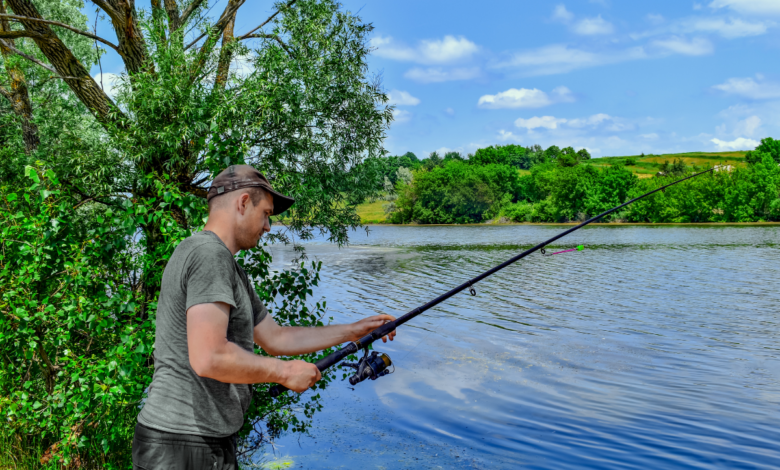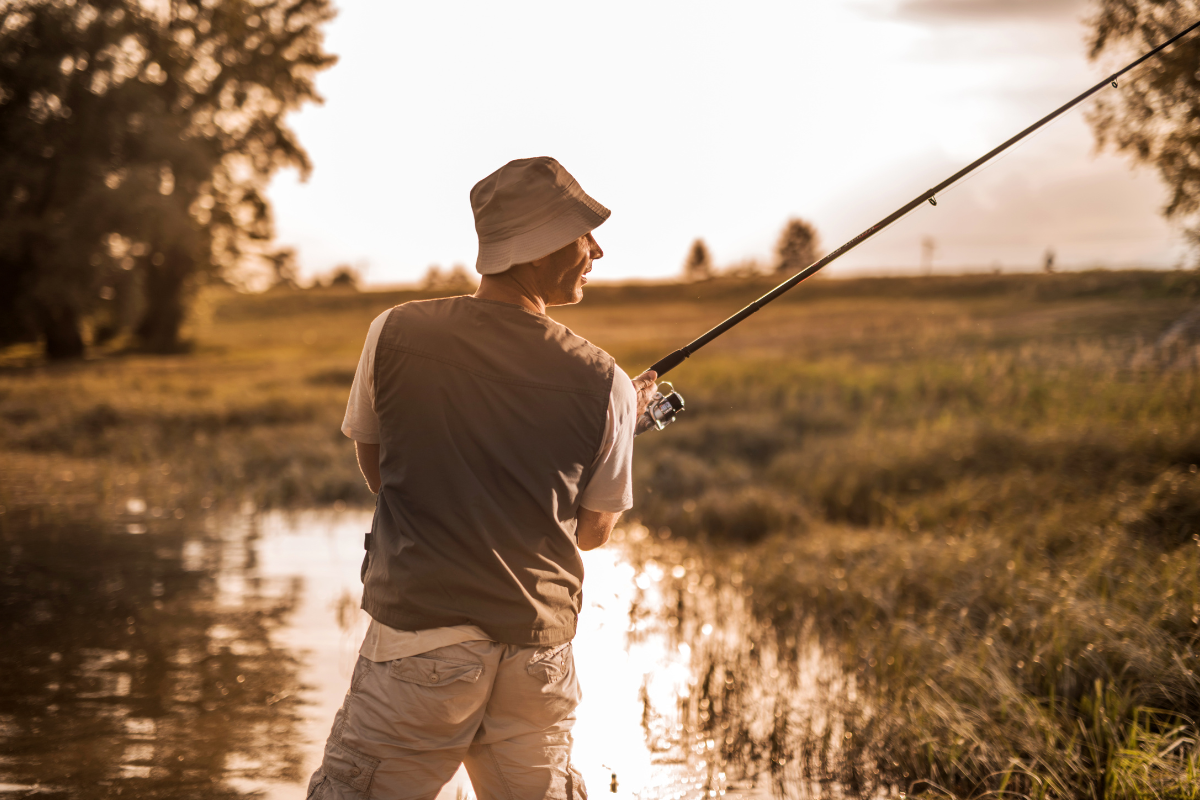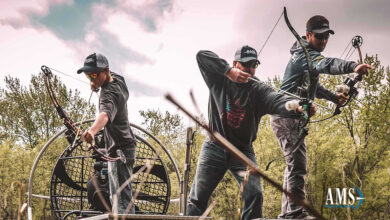How to Fish For Bass From the Shore: Top Tips

I have to admit that the chances of catching bass from the boat are higher than from the shore. But, does that make bass fishing from shore a less enjoyable experience?
Not really, no.
Imagine reeling bass in after patiently waiting for hours around submerged rocks and old docks. I personally love shore fishing.
However, you need to be observant and make the best use of the conditions for catching bass from the shore.
If you are wondering how to fish for bass from shore, these tips will help you to improve your chances.
Best Spots to Fish From the Shore
The chances of finding bass are higher in any spot that offers a combination of cover and food sources. Here are some hot spots that offer a higher chance of catching bass.
Visible Cover
Fallen trees, boulders, submerged roots, and rocks are some of the favorite covers for bass. Dense vegetation on the shoreline can make accessing such spots challenging, but the bass love to hide and ambush the prey from these locations.
Brush Piles
One of the best tips I received from a veteran angler for shore bass fishing is to look for brush piles. In fact, many bass guides plant brush piles in deep and shallow waters to increase the strike rates for clients.
Feeder Creeks
What makes narrow feeder creeks or spillways originating from a waterbody special?
Generally, they hold a healthy crayfish population. And crayfish are a protein-rich dish that the bass loves to devour.
In most cases, the mouth of the creeks also indicates a contour change. Look closely, and you will find ditches formed in that zone due to the constant flow of water. Many times. I have found the larger bass in these spots.
Docks and Piers
Docks and piers form excellent covers that shelter baitfish. While bass fishing at Lake Erie, I noticed that older piers with rotten wood and chipped corners tend to hold more baitfish. This, in turn, attracts more bass.
Another reason that bass is found around these spots is most docks extend into deeper waters from the shore. This provides the ideal transition zones for deep-water bass to move.
The Best Time to Fish From the Shore
For successful bass fishing from shore, you need to understand the bass behavior for every season. Next, learn about the daily habits of bass. Combining these two aspects is the key to shore bass fishing.
In winter, bass tend to be sluggish and move deeper. So don’t expect much action while shore fishing. Early spring bass fishing is about looking closely at the bass migration pattern. Bass activity rises during the spawning period in spring, as the bass will move to shallow waters.
As the temperatures rise in summer, bass will head towards deeper and cooler water to avoid the sun. You need to find shorelines from where you can access these deep waters. The other option is to fish during the low-light periods of dawn and dusk. These are times when bass head for shallow water to look for prey.
Fishing at night is another great idea. I find full moon nights extremely productive for shore fishing. The faint light and cooler water temperatures are ideal for luring the bass with the right baits. However, cold and pitch-black nights are best avoided.
In fall, my standard bass fishing tactic is to follow the baitfish and locate spots where they congregate.
If these are transition areas along the shore where the deep water changes to shallow, even better. As the temperature drops in late fall, bass tend to seek the pools of warmer water. Pre-spawn flat zones and creek mouths are good spots to focus on.
Check out this episode of Straight Up Fishing and see how Brian makes the most of his first time filming from the bank:
The Best Bass Fishing Lures When Shore Fishing
These days, with so many types of lures available, making the right choice can get confusing. To clear the clutter, here are some of the best options for shore bass fishing.
Spinnerbait
Spinnerbaits are one of the best pre-spawn bass lures, especially when the water is murky. Off-color water will prevent the bass from seeing the bait clearly.
Spinnerbaits have different sizes, blade geometry, and blade combinations. Choosing the right one depends on multiple factors like the season, the water color, and depth.
If the water is deep, I allow the bait to sink to the bottom. I keep the reeling speed low, allowing the bait to drag across the bottom. When the water is less dirty, I move the bait faster. Basically, the trick is to make the spinnerbait look like a live prey.
Texas Rigged Worm
Without a doubt, the Texas rig is the most versatile option for bass fishing. It can be used in varying water depths and over rocks, grass, and roots.
Weightless Texas rigged worms will make the bait drop slowly and work great when the water is clear. Or else you can add bullet weights to the worm to make it crawl along the bottom.
Working the worm through shallow moss beds or dense covers will need some practice. For newbies, detecting a strike in the rigged worm can be challenging. You need to be a line watcher and stay in contact with the line to feel the tap.
Swimbait
Many anglers pick the swimbait to draw bigger bites from trophy bass. These baits have a realistic look and great action that closely resembles baitfish. That helps to draw the bass towards moderately clear waters near the shore.
Swimbaits can be used in almost any location between spring and fall. They are divided into hard and soft categories based on the materials used.
One of my favorite ways of using larger hard swimbaits is throwing from a dock area at night. I ended up with an 11-pounder from one such night cast.
Topwater
Topwater lures are hard to beat when the bass is hanging in the water column. They work very well in low light conditions when the water temperatures are on the higher side. Remember, these lures will not work on windy days when the water is choppy.
In my experience, topwaters work best when the water depth is 5 to 10 feet. Two of my favorite choices on shallow shorelines are poppers and frog-style topwater lures. Make sure to pick colors that closely match the baitfish.

Gear Needed For Fishing From the Shore
There have been occasions where I observed this during fishing. Then I learned that bass learn from their experience too. So while it’s best to start with the standard combination of fishing gears, never hesitate to try new things, especially with lures.
Lures
A weedless rig is a good choice when you want an easy retrieve through dense covers. An exposed hook getting snagged is a real pain. You can either use a weed guard or hook the bait in a weedless manner. With the second method, there is no chance of the weed guard breaking off, leaving the hook exposed.
Bait choice should be based on the conditions. The traditional worm design with the right type of sinker is my favorite choice as it works in shallows as well as deeper waters. I keep a few color options in my tackle box to match the water clarity and baitfish situation.
Beyond artificial baits, live baits like shiners and shad are great for bass as well. Other options include frogs, insects, and worms. In new locations where bass behavior is unknown, live baits can work in your favor.
Rod and Reel
In most cases, the rod length is a matter of personal preference. Longer rods give you the extra distance that helps in some situations.
However, shorter rods are lighter and easier to handle and make precise casts. The action of the rod, or how much it flexes will depend on the fishing technique and the type of lure being used.
There are various types of fishing rods available. In my experience, a medium-action rod with average sensitivity works in most cases. A length between seven to nine feet is good to start with.
For small to medium-sized rods, a size 4000-5000 spinning reel is a good choice. If you use a smaller rod of seven feet, a 2500-size reel can also work well. Make sure that the reel is made from a durable and lightweight material.
Fishing Line
Now, every angler has their favorite line type preferences. In reality, all three line types- fluorocarbon, monofilament, and braid- have their pros and cons.
My choice is the monofilament line as they are super versatile and inexpensive. The higher elasticity allows this line to stretch, making it more forgiving. On the downside, it is harder to sense light strokes on a mono line. But once you get the feel of it, it works fine for everyday fishing.
If you want more sensitivity, pick a braided line as they have minimum stretch and excellent abrasion resistance. But, braided lines are expensive. One way to pick the right type of fishing line on a budget is by combining around 100 yards of the braid with monofilament to fill the reel.
While fishing from shore for bass, a line of 8-12 pound strength is good enough. In case the cover is thick, or the bait is heavier, bump it up to 20-30 pounds.
How to Fish For Bass From the Shore: FAQs
What is the best bait for bass on the shore?
The best baits for bass on the shore are realistic soft plastic baits and live baits.
How do you target bass from the shore?
To target bass from the shore you need to pick the right spots where their prey hang around. The best spots are near natural or artificial covers.
What color lure is best for shore fishing?
A neutral or light color like white works well while fishing from shore in clear waters. When the water is muddy, shift to brighter colors.
Final Thoughts
Hope that answers the question- how to fish for bass from shore. These tips have been tried and tested by numerous bass anglers over the years.
With the right gear, there are multiple options that you can try out in a location to match what the bass is seeking. Remember, trial and error is an integral part of shore fishing, and finding the right combination takes time.
Once you have it figured out, shore bass fishing is a lot of fun.



